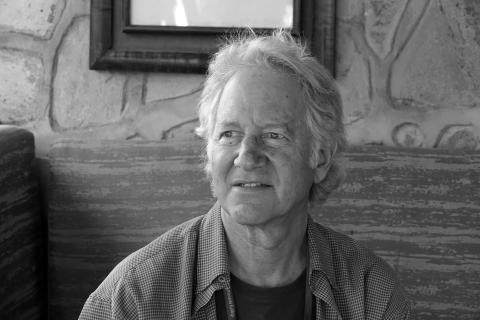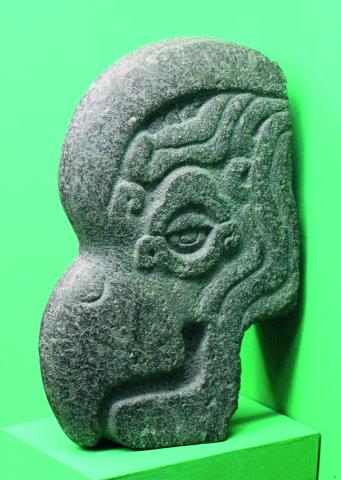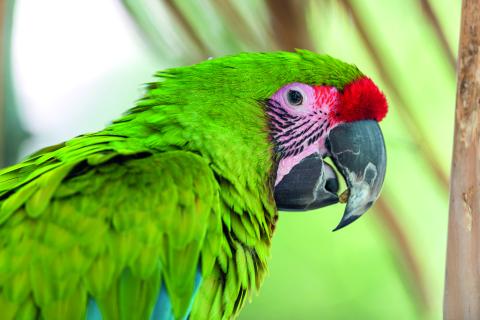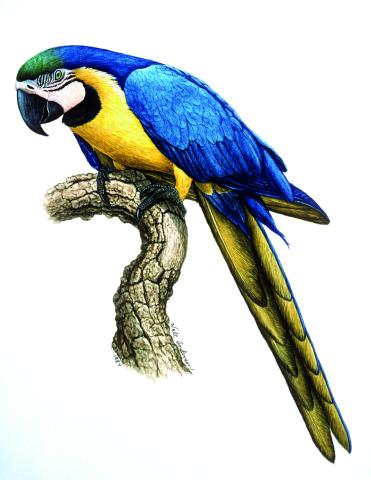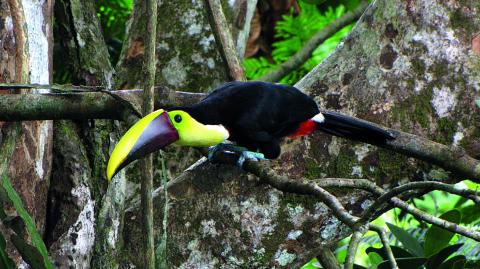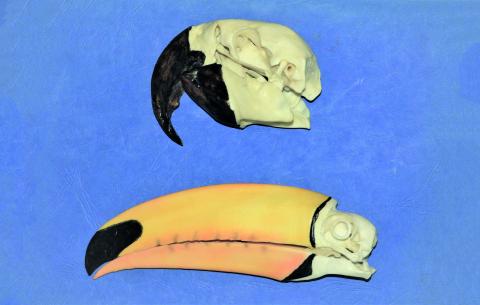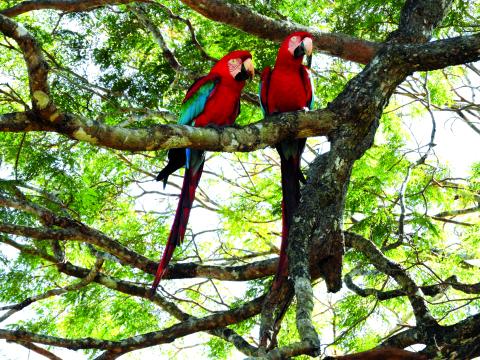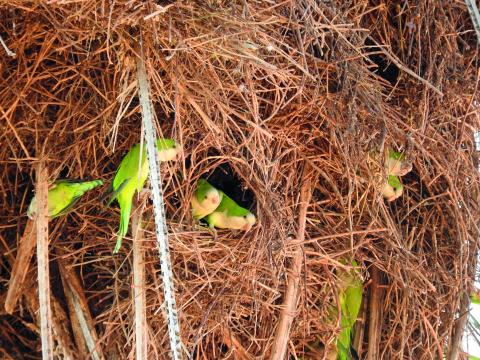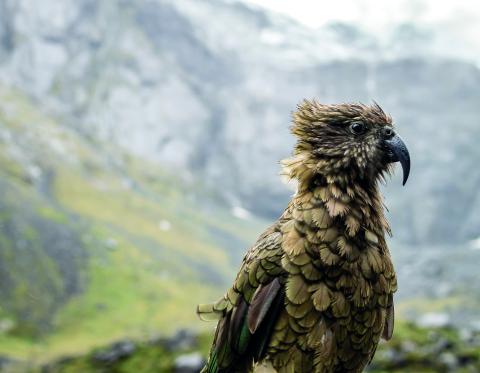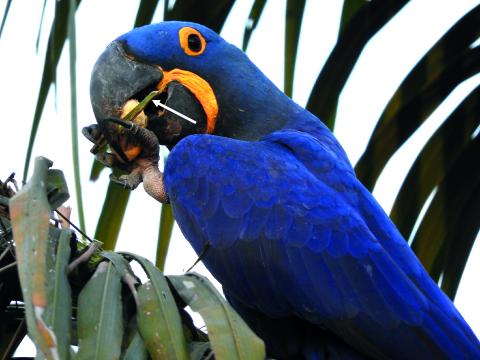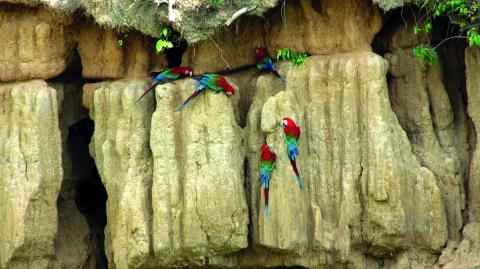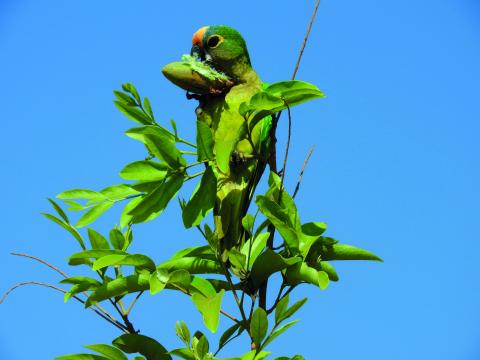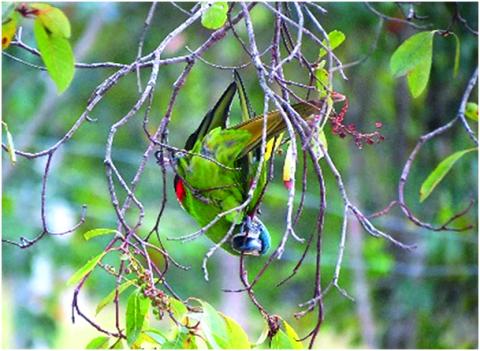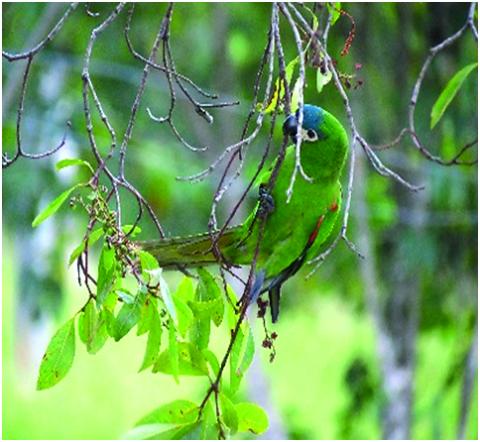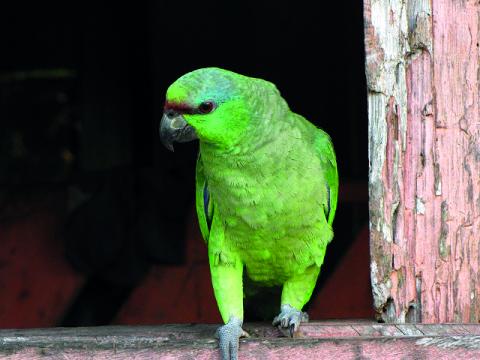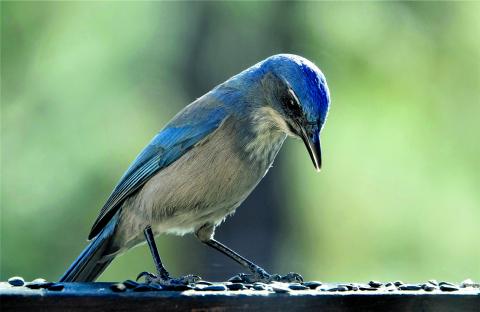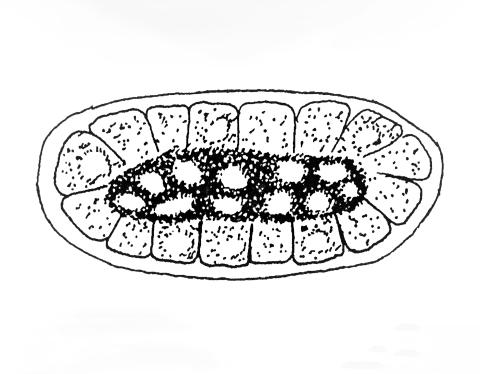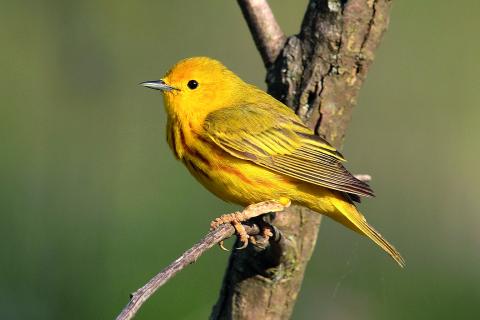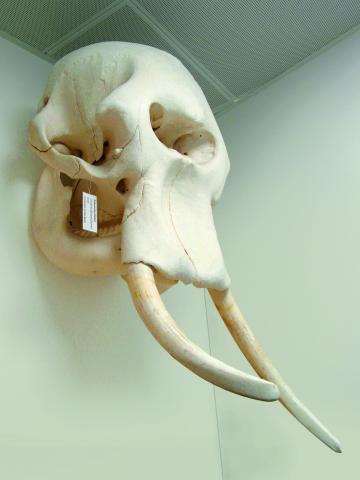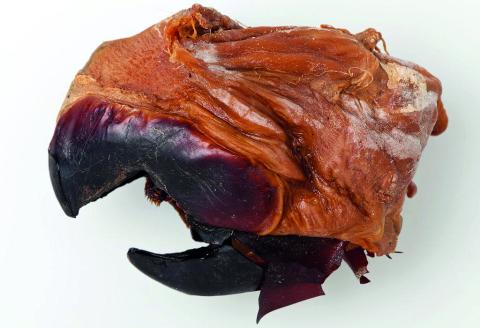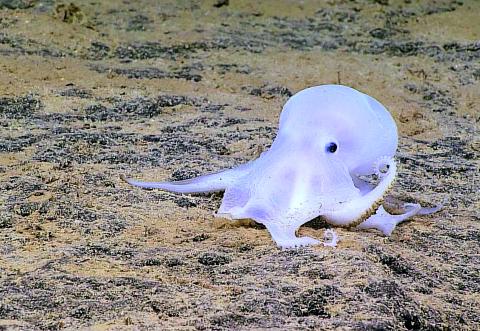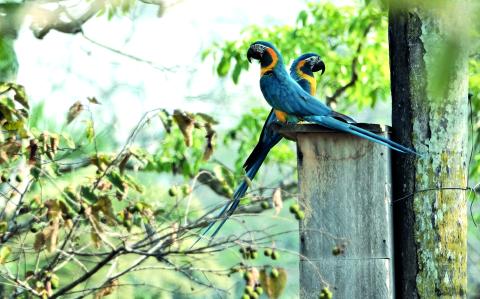Parrots and People
A Morphodynamic Convergence
Export Article Citation as
- Download price : €6
Abstract:
The approximately 398 species of living parrots (macaws, parakeets, cockatoos, etc.) comprise a more or less homogeneous group of birds found mostly in tropical and subtropical regions. No other group of wild birds has attracted such strong human interest, and conse- quently parrots are the most popular avian pets around the world, from the tropics to the temperate zone. What is it about parrots that draws our interest? In this paper I propose that parrots share many morphological, developmental, and behavioral features with humans. While parrot intelligence, ability to mimic human speech, and strong family bonds are well- known features that converge with human characteristics, I point out additional overlooked humanlike traits of parrots, from their spherically-shaped head to their highly developed grasping ability. Regarding the latter, the prehensility of the parrot’s foot – which enables birds to manipulate food and bring items to the mouth – has no equal among modern birds and is convergent with the dexterity of the human hand. Furthermore, there is evidently an association between intelligence, i.e., cognitive ability, and prehensility, and additional animal examples are discussed briefly. The sheer number of similarities between parrots and people calls for a reconsideration of evolutionary dynamics. Accordingly, evolution can be under- stood as not only the result of the organism’s cumulative response and accommodation to shifting external conditions of the environment but also to the internal integration and coher- ence of dynamically interacting anatomical, morphological, behavioral, and developmental processes. The phenomenological and conceptual framework of convergent morphodyna- mics is well suited to shed light on these dynamic relationships.
References
- Almécija, S., Smaers, J. B., Jungers, W. L. (2015): The evolution of human and ape hand pro- portions. Nature Communications 6: 7717. doi:10.1038/ncomms8717
- Anderson, R. C., Schimek, R., Cosgrove, J. A., Berthinier, S. (2007): Giant Pacific octopus, Enteroctopus dofleini, attacks on divers. Canadian Field-Naturalist 121: 423–425
- Anderson, R. C., Schimek, R., Cosgrove, J. A., Berthinier, S. (2007): Giant Pacific octopus, Enteroctopus dofleini, attacks on divers. Canadian Field-Naturalist 121: 423–425
- Bird, R. J. (2003): Chaos and Life: Complexity and Order in Evolution and Thought. Columbia University Press: New York
- Blanco, G., Bravo, C., Pacifico, E. C. & al. (2016): Internal seed dispersal by parrots: An over- view of a neglected mutualism. PeerJ 4: e1688. Doi: 10.7717/peerj.1688
- Bond, A. B., Diamond, J. (2019): Thinking Like a Parrot: Perspectives from the Wild. University of Chicago Press: Chicago, Illinois
- Borsari, A., Ottoni, E. B. (2005): Preliminary observations of tool use in captive hyacinth macaws (Anodorhynchus hyacinthinus). Animal Cognition 8: 48–52
- Borsari, A., Ottoni, E. B. (2005): Preliminary observations of tool use in captive hyacinth macaws (Anodorhynchus hyacinthinus). Animal Cognition 8: 48–52
- Botelho, J. F., Smith-Paredes, D., Vargas, A. O. (2015): Altriciality and the evolution of toe orientation in birds. Evolutionary Biology 42: 502–510
- Brucks, D., von Bayern, A. M. P. (2020): Parrots voluntarily help each other to obtain food rewards. Current Biology 30: 1-6
- Bryson, B. (2019): The Body: A Guide for Occupants. Doubleday: New York
- Burish, M. J., Kueh, H. Y., Wang, S. S.-H. (2004): Brain architecture and social complexity in modern and ancient birds. Brain, Behavior and Evolution 63: 107–124
- Carroll, S. B. (2005): Endless Forms Most Beautiful: The New Science of Evo-devo. W. W. Norton and Company: New York
- Carroll, S. B. (2006): The Making of the Fittest: DNA and the Ultimate Forensic Record of Evolution. W. W. Norton and Company: New York
- Chakraborty, M., Walløe, S., Nedergaard, S. & al. (2015): Core and shell song systems unique to the parrot brain. PLoS ONE 10(6): e0118496. doi:10.1.1371/journal.pone.0118496
- Charvet, C. J., Striedter, G. F. (2011): Developmental modes and developmental mechanisms can channel brain evolution. Frontiers in Neuroanatomy 5. doi: 10.3389/fnana.2011.00004
- Collar, N. J. (1997): Family Psittacidae (Parrots). In del Hoyo, J., Elliott, A., Sargatal, J. (Eds.). Handbook of the Birds of the World, Vol. 4, pp. 280–477: Sandgrouse to Cuckoos. Lynx Edicions: Barcelona, Spain
- Cooke, T. F., Fischer, C. R., Wu, P. & al. (2017): Genetic mapping and biochemical basis of yellow feather pigmentation in budgerigars. Cell 171(2): 427–439
- Corballis, M. C. (2007): The uniqueness of human recursive thinking. American Scientist 95: 240-248
- del Hoyo, J. (Ed.). (2020): All the Birds of the World. Lynx Edicions: Barcelona, Spain
- Diamond, J., Bond, A. B. (2003): A comparative analysis of social play in birds. Behaviour 140: 1091–1115
- Drake, N. (2014): What’s behind the mysterious behavior of Amazonian macaws? Wired Science https://www.wired.com/2014/01/tambopata-macaw-project/; accessed August 29, 2018
- Eggleston, R., Viloria, N., Delgado, S. & al. (2022): Vocal babbling in a wild parrot shows life history and endocrine affinities with human infants. Proc. R. Soc. B 289: 20220592. https://doi.org/10.1098/rspb.2022.0592
- Ehrlich, P. R., Dobkin, D. S., Wheye, D. (1988): The Birder’s Handbook: A Field Guide to the Natural History of North American Birds. Simon and Schuster, Inc.: New York
- Elsner, P. (2013): Metamorphosis in Nature and Art: The Dynamics of Form in Plants, Animals and Human Beings. Hawthorn Press: Stroud, United Kingdom
- Emerson, R. W. (1883): The Works of Ralph Waldo Emerson: His Essays, Lectures, Poems, and Orations; Vol. 1. George Bell and Sons: London
- Emery, N. J., Seed, A. M., von Bayern, A. M. P., Clayton, N. S. (2007): Cognitive adaptations of social bonding in birds. Philosophical Transactions of the Royal Society B: 362: 489–505
- Forshaw, J. M. (2017): Vanished and Vanishing Parrots: Profiling Extinct and Endangered Species. Cornell University Press: Ithaca, New York
- Goethe, J. W. von (1790): The Metamorphosis of Plants. G. L. Miller (Introduction and photo- graphy). (2009): MIT Press: Cambridge, Massachusetts
- Gómez, J. M., Verdú, M., González-Megías, A., Méndez, M. (2016): The phylogenetic roots of human lethal violence. Nature 538: 233–237
- Gould, S. J. (1977): Ontogeny and Phylogeny. Harvard University Press: Cambridge, Massa- chusetts
- Gutiérrez-Ibáñez, C., Iwaniuk, A. N., Wylie, D. R. (2018): Parrots have evolved a primate-like telencephalic-midbrain-cerebellar circuit. Nature Scientific Reports 8: 9960. DOI:10.1038/ s41598-018-28301-4
- Hall, B. K., Olson, W. M. (Eds.). (2003): Keywords and Concepts in Evolutionary Developmental Biology. Harvard University Press: Cambridge, Massachusetts
- Heinsohn, R., Zdenek, C. N., Cunningham, R. B. & al. (2017): Tool-assisted rhythmic drumming in Palm Cockatoos shares key elements of human instrumental music. Science Advances (3): e1602399
- Hill, G. E. (2010): National Geographic Bird Coloration. National Geographic Society: Washington, D.C.
- Holdrege, C. (2003): The flexible giant: Seeing the elephant whole. Nature Institute Perspectives 2. The Nature Institute: Ghent, New York
- Holdrege, C. (2021): Seeing the Animal Whole and Why it Matters. Lindisfarne Press: Hudson, New York
- Iwaniuk, A. N., Dean, K. M, Nelson, J. E. (2005): Interspecific allometry of the brain and brain regions in parrots (Psittaciformes): Comparisons with other birds and primates. Brain, Behavior and Evolution 65: 40–59
- Iwaniuk, A. N., Nelson, J. E. (2003): Developmental differences are correlated with relative brain size in birds: A comparative analysis. Canadian Journal of Zoology 81: 1913–1928
- Jetz, W., Thomas, G. H., Joy, J. B. & al. (2012): The global diversity of birds in space and time. Nature 491: 444-448. doi:10.1038/nature11631
- Juniper, T., Parr, M. (1998): Parrots: A Guide to Parrots of the World. Yale University Press: New Haven, Connecticut
- Kennedy, E. B. L., Buresch, K. C., Boinapally, P., Hanlon, R. T. (2020): Octopus arms exhibit exceptional flexibility. Nature Scientific Reports 10: 20872. https://doi.org/10.1038/s41598- 020-77873-7
- Kipp, F. (2005): Childhood and Human Evolution. Adonis Press: Ghent, New York
- Klump, B. C., Martin, J. M., Wild, S. & al. (2021): Innovation and geographic spread of a complex foraging culture in an urban parrot. Science 373: 456–460
- König, K. (2013): Animals: An Imaginative Zoology. Floris Books: Edinburgh, Scotland
- Löbe, N., Rang, M., Vine, T. (2022): Seeing Colour: A Journey Through Goethe’s World of Colour. Floris Books: Edinburgh, Scotland
- Lockley, M. G. (2007): The morphodynamics of dinosaurs, other archosaurs, and their trackways: holistic insights into relationships between feet, limbs, and the whole body. In Bromley, R., Melchor, R. (Eds.), Ichnology at the Crossroads: A Multidimensional Approach to the Science of Organism-substrate Interactions, pp. 27–51. Society of Economic Paleontologists and Mineralogists Special Publication 88
- Lockley, M. G., Jackson, P. (2008): Morphodynamic perspectives on convergence between the feet and limbs of sauropods and humans: Two cases of hypermorphosis. Ichnos 15: 140–157
- Marks, J. S., Cannings, R. J., Mikkola, H. (1999): Family Strigidae (Typical Owls). In del Hoyo, J., Elliott, A., Sargatal, J. (Eds.), Handbook of the Birds of the World, Vol. 5, pp. 76–242: Barnowls to Hummingbirds. Lynx Edicions: Barcelona, Spain
- McNamara, K. J. (1997): Shapes of Time: The Evolution of Growth and Development. The Johns Hopkins University Press: Baltimore, Maryland
- Merwin, J. T., Seeholzer, G. F., Smith, B. T. (2020): Macroevolutionary bursts and constraints generate a rainbow in a clade of tropical birds. BMC Evolutionary Biology 20: 32. https://doi.org/10.1186/s12862-020-1577-y
- Miller, D. E. (Ed. and Transl.). (1995): Goethe: Scientific Studies. Princeton University Press: Princeton, New Jersey
- Munn, C. A. (1994): Macaws: Winged rainbows. National Geographic 185(1): 118–140
- Olkowicz, S., Kocourek, M., Lu an, R. K. & al. (2016): Birds have primate-like numbers of neurons in the forebrain. PNAS 113(26): 7255–7260
- Osuna-Mascaro, A. J., O’Hara, M., Folkertsma, R. & al. (2003): Flexible tool set transport in Goffin’s cockatoos. Current Biology 33: 849–857
- Pepperberg, I. M. (2008): Alex and Me: How a Scientist and a Parrot Discovered a Hidden World of Animal Intelligence – and Formed a Deep Bond in the Process. Harper-Collins: New York
- Pruett-Jones, S. (Ed.). (2021): Naturalized Parrots of the World: Distribution, Ecology, and Impacts of the World’s Most Colorful Colonizers. Princeton University Press: Princeton, New Jersey
- Riegner, M. F. (1998): Horns, hooves, spots, and stripes: Form and pattern in mammals. In Sea- mon, D., Zajonc, A. (Eds.), Goethe’s Way of Science: A Phenomenology of Nature, pp. 177–212. SUNY Press: Albany, New York
- Riegner, M. F. (2008): Parallel evolution of plumage pattern and coloration in birds: Implications for defining avian morphospace. The Condor 110: 599–614
- Riegner, M. F. (2013): Ancestor of the new archetypal biology: Goethe’s dynamic typology as a model for contemporary evolutionary developmental biology. Studies in History and Philosophy of Biological and Biomedical Sciences 44: 735–744
- Robison, B., Seibel, B., Drazen, J. (2014): Deep-sea octopus (Graneledone boreopacifica) conducts the longest-known egg-brooding period of any animal. PLoS One 9(7): e103437. doi:10.1371/journal.pone.0103437
- Rosslenbroich, B. (2014): On the Origin of Autonomy: A New Look at the Major Transitions in Evolution. Springer: New York
- Sassoon, J. (2020): Goethe’s spirit haunts a new dynamic biology. Elemente der Naturwissenschaft 113: 5–18
- Schad, W. (1977): Man and Mammals: Toward a Biology of Form. Waldorf Press: Garden City, New York
- Schad, W. (1993): Heterochronical patterns of evolution in the transitional stages of vertebrate classes. Acta Biotheoretica 41: 383–389
- Schad, W. (2020): Threefoldness in Humans and Mammals: Toward a Biology of Form. Adonis Press: Harlemville, New York
- Schulz, A. K., Boyle, M., Boyle, C., Hu, D. L. (2022): Skin wrinkles and folds enable asymmetric stretch in the elephant trunk. Proceedings of the National Academy of Sciences 119(31): e2122563119
- Seilacher, A., Gishlick, A. D. (2020). Morphodynamics. CRC Press: Boca Raton, Florida
- Starck, J. M., Ricklefs, R. E. (Eds.). (1998): Avian Growth and Development: Evolution Within the Altricial-precocial Spectrum. Oxford University Press: New York
- Steiner, R. (1995): Intuitive Thinking as a Spiritual Path: A Philosophy of Freedom. Anthroposophic Press: Great Barrington, Massachusetts
- Suh, A., Paus, M., Kiefmann, M. & al. (2011): Mesozoic retroposons reveal parrots as the closest living relatives of passerine birds. Nature Communications 2: 443
- Sumbre, G., Fiorito, G., Flash, T., Hochner, B. (2006): Octopuses use a human-like strategy to control precise point-to-point arm movements. Current Biology 16: 767–772
- Tella, J. L., Hiraldo, F., Pacífico, E. & al. (2020): Conserving the diversity of ecological inter- actions: The role of two threatened macaw species as legitimate dispersers of »megafaunal« fruits. Diversity 12(45). doi:10.3390/d12020045
- Thompson, D. W. (1961): On Growth and Form; abridged edition. Cambridge University Press: New York, New York
- Tinbergen, J., Wilts, B. D., Stavenga, D. G. (2013): Spectral tuning of Amazon parrot feather coloration by psittacofulvin pigments and spongy structures. Journal of Experimental Biology 216: 4358–4364
- Toft, C.A., Wright, T. F. (2015): Parrots of the Wild: A Natural History of the World’s Most Captivating Birds. University of California Press: Oakland, California
- Turner, D. A. (1997): Family Musophagidae (Turacos). In del Hoyo, J., Elliott, A., Sargatal, J. (Eds.), Handbook of the Birds of the World, vol. 4, pp. 480–506: Sandgrouse to Cuk- koos. Lynx Edicions: Barcelona, Spain
- Verhulst, J. (2003): Developmental Dynamics in Humans and Other Primates: Discovering Evo- lutionary Principles Through Comparative Morphology. Adonis Press: Ghent, New York
- Waterhouse, D. M. (2006): Parrots in a nutshell: The fossil record of Psittaciformes (Aves). Historical Biology 18(2): 223–234
- West-Eberhard, M. J. (2003): Developmental Plasticity and Evolution. Oxford University Press: New York
- Winkler, D. W., Billerman, S. M., Lovette, I. J. (2015): Bird Families of the World: An Invitation to the Spectacular Diversity of Birds. Lynx Edicions: Barcelona, Spain
- Wirthlin, M., Lima, N. C. B., Guedes, R. L. M. & al. (2018): Parrot genomes and the evolution of heightened longevity and cognition. Current Biology 28: 4001–4008
- Young, M. W., Dickinson, E., Flaim, N. D., Granatosky, M. C. (2022): Overcoming a »for- bidden phenotype«: The parrot’s head supports, propels and powers tripedal locomotion. Proceedings of the Royal Society B 289: 20220245. https://doi.org/10.1098/rspb.20220245


